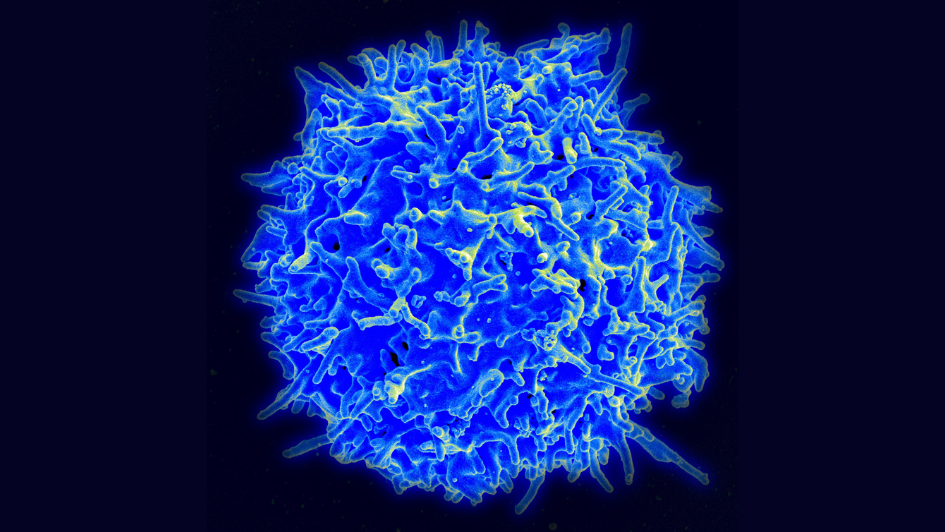
Image: Scanning electron micrograph of a human T lymphocyte (also called a T cell) from the immune system of a healthy donor. Credit: NIAID/NIH.
Scientists have developed a new way of using cancers’ DNA to spot cancer patients who may benefit from immunotherapy.
Researchers developed a computer algorithm to tell the difference between two different strategies that tumours use to hide from the immune system - one of which is better at dodging the effects of immunotherapy than the other.
A team led by scientists at The Institute of Cancer Research, London and the Human Technopole in Milan found that the algorithm could help guide treatment by predicting whether immunotherapy is likely to work. It also tells us more about the evolutionary arms race between cancer and the immune system, potentially supporting efforts to diagnosis and treat cancers earlier.
The study is published in the major journal Nature Genetics today and was largely funded by the European Union’s Marie Skłodowska-Curie Actions, with additional support from Wellcome and Cancer Research UK.
‘Hiding’ from the immune system
The body’s immune system can recognise cells as being foreign by detecting ‘molecular flags’ on their surface, known as neoantigens.
But cancer can adopt two different strategies to hide from the immune system. Some cancer cells use a ‘cloaking’ mechanism to escape the immune response even though they have these neoantigens on their surface, while others ‘edit’ the number of neoantigens on their surface to supress the immune response.
Using genomic data from 10,000 cancer samples across 33 cancer types available from the Cancer Genome Atlas, researchers developed a computer algorithm that works out which strategy cancer cells are using to evade the immune system.
By looking at the excess number of neoantigens present in a tumour compared with the number of mutations, the model can differentiate between the two strategies, known as immune escape and immune edited.
The team applied their algorithm to 308 cancers from the Hartwig Medical Foundation that had spread to other parts of the body and had been treated with immunotherapy, including skin, lung, and head and neck cancers. Of these, 26 per cent responded well to immunotherapy. These cancers tended to be immune-escaped tumours, as they had a greater average excess of neoantigens than the cancers that did not respond as well.
Removing cancer's ‘invisibility cloak’
Immunotherapy removes the ‘invisibility cloak’ placed on cancer cells by these immune-escape strategies, revealing them to the immune system.
The researchers are now working to apply their algorithm to healthy cells and other tumour types. Using this information, they hope to identify at what point initial cloaking by cells triggers the development of cancer – opening up potential opportunities to detect cancer earlier.
In the future, their algorithm could be used to identify which patients would best respond to immunotherapy based on if their tumour cells are immune-escaped or immune-edited. This could save patients from potentially harmful side-effects while being more cost-effective for the NHS.
The ICR scientists who led the study are based in the ICR’s Centre for Evolution and Cancer, which has pioneered the understanding of cancer through the lens of evolution. The ICR is seeking philanthropic support for the Centre, which will play a key role in the search for new cancer treatments.
Personalising treatment
Study first author, Dr Luis Zapata Ortiz, Fellow in Evolutionary Genomics and Modelling at The Institute of Cancer Research, London, said:
“Cancers can play a ‘hide-and-seek’ game against the immune system by either hiding all their neoantigens that can be detected by the immune system, or by depleting the pool of neoantigens needed for a successful immune response.
“We have developed an algorithm, using Darwin’s principles of evolution, to identify which patients will benefit from immunotherapy based on the interactions between their cancer and immune cells. Our algorithm has the potential to personalise patient treatment using the latest genomic technologies available in the clinic. It could also save some cancer patients unnecessary side effects and be more cost-effective for the NHS.
“We hope to now apply our algorithm to healthy cells to see at what point a seemingly healthy cell turns cancerous. This could pave the way for a new method of early cancer detection, helping us to target cancer when the disease is at its most treatable.”
Study co-leader, Professor Trevor Graham, Director of the Centre for Evolution and Cancer at The Institute of Cancer Research, London, said:
“To survive in our body, cancer cells will need to find a way to hide from our immune system – either by adopting a kind of cloaking mechanism, or by reducing the number of neoantigens they produce on the cell surface.
“Our algorithm can tell the difference between the different strategies cancer cells use to evade the immune system, and so make a prediction of the likelihood that immunotherapy will be effective. It can spot cancer cells which still have high numbers of neoantigens, and which therefore could be recognised by the immune system with a helping hand from immunotherapy.”
Study co-leader Professor Andrea Sottoriva, Head of the Computational Biology Research Centre at Human Technopole in Milan, said:
“Immunotherapy is an incredibly effective treatment that works by harnessing the body’s own immune system to fight cancer. However, until now, it has been difficult to understand why some patients respond to immunotherapy better than others.
“Our algorithm could predict which patients will respond best to immunotherapy based on the type of avoidance strategy used by their tumour. Those whose cancers possess immune-escape strategies will respond better to immunotherapy than those with immune-edited strategies. This is because this treatment removes the ‘invisibility cloak’ used by immune-escaped cancer cells, making them now visible to the immune system.
“We hope that our algorithm can be used as a tool to help devise better treatment strategies for patients in the future.”

 .
.
 .
.